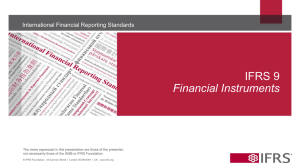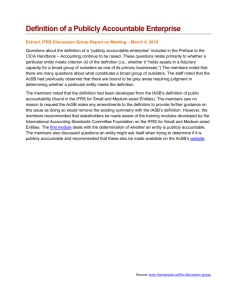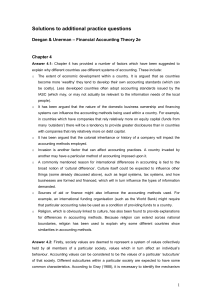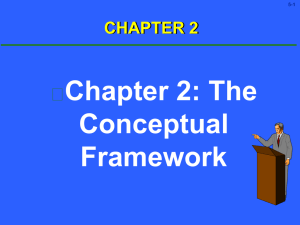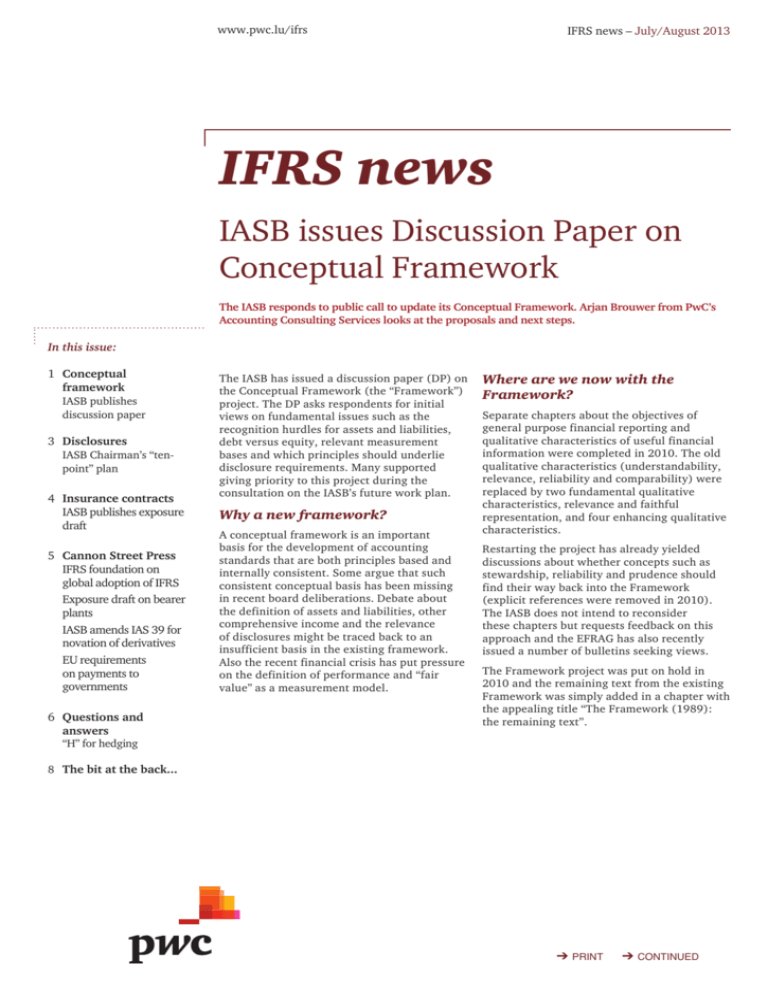
www.pwc.lu/ifrs
IFRS news – July/August 2013
IFRS news
IASB issues Discussion Paper on
Conceptual Framework
The IASB responds to public call to update its Conceptual Framework. Arjan Brouwer from PwC’s
Accounting Consulting Services looks at the proposals and next steps.
In this issue:
1 Conceptual
framework
IASB publishes
discussion paper
3 Disclosures
IASB Chairman’s “tenpoint” plan
4 Insurance contracts
IASB publishes exposure
draft
5 Cannon Street Press
IFRS foundation on
global adoption of IFRS
Exposure draft on bearer
plants
IASB amends IAS 39 for
novation of derivatives
EU requirements
on payments to
governments
6 Questions and
answers
The IASB has issued a discussion paper (DP) on
the Conceptual Framework (the “Framework”)
project. The DP asks respondents for initial
views on fundamental issues such as the
recognition hurdles for assets and liabilities,
debt versus equity, relevant measurement
bases and which principles should underlie
disclosure requirements. Many supported
giving priority to this project during the
consultation on the IASB’s future work plan.
Why a new framework?
A conceptual framework is an important
basis for the development of accounting
standards that are both principles based and
internally consistent. Some argue that such
consistent conceptual basis has been missing
in recent board deliberations. Debate about
the definition of assets and liabilities, other
comprehensive income and the relevance
of disclosures might be traced back to an
insufficient basis in the existing framework.
Also the recent financial crisis has put pressure
on the definition of performance and “fair
value” as a measurement model.
Where are we now with the
Framework?
Separate chapters about the objectives of
general purpose financial reporting and
qualitative characteristics of useful financial
information were completed in 2010. The old
qualitative characteristics (understandability,
relevance, reliability and comparability) were
replaced by two fundamental qualitative
characteristics, relevance and faithful
representation, and four enhancing qualitative
characteristics.
Restarting the project has already yielded
discussions about whether concepts such as
stewardship, reliability and prudence should
find their way back into the Framework
(explicit references were removed in 2010).
The IASB does not intend to reconsider
these chapters but requests feedback on this
approach and the EFRAG has also recently
issued a number of bulletins seeking views.
The Framework project was put on hold in
2010 and the remaining text from the existing
Framework was simply added in a chapter with
the appealing title “The Framework (1989):
the remaining text”.
“H” for hedging
8 The bit at the back...
➔
Print
➔
Continued
www.pwc.lu/ifrs
• Liabilities and equity: The DP retains
the existing definition of “equity” as
the “residual interest in the assets
after deducting all liabilities”. But it
proposes “remeasuring” each class
of equity and recognising those
remeasurements as a transfer of
wealth between classes.
The discussion paper
• Measurement: The proposed
objective of measurement is to
represent faithfully the most relevant
information. The IASB has not
expressed an explicit preference
for one measurement model. The
DP acknowledges that a mix of
measurement models might result in
relevant information depending on
the nature of the element.
The Board restarted the project in
2012 and forged ahead with the DP
focusing on the remaining areas of the
Framework. The DP invites interested
parties to reflect on Board proposals in
certain areas and a range of alternatives
in other areas. Some highlights are:
• Presentation: The Board does not
plan to define “performance” in the
Framework but the debate about what
goes in other comprehensive income
is ongoing. The IASB suggests a
number of possible options for dealing
with this going forward.
• Elements: The DP proposes that
probability is no longer part of the
definition of an asset or liability. The
definitions now focus on whether a
past event provides control over a
right (or obligation) to receive (or
transfer) economic resources. The
IASB also asks for input on several
possible approaches on how the
definitions should be applied to
conditional obligations.
• Disclosure: The DP complements
the ongoing work by the IASB on
disclosures. The IASB proposes that
the Framework focuses on relevance
and emphasises communication
principles which should support
efforts to reduce clutter.
• Recognition: Assets and liabilities
would be recognised unless their
recognition would not result
in relevant information or no
measurement basis would result in a
faithful representation.
IFRS news – July/August 2013
scope might make the the Framework
“future proof”. However, the choice
is understandable to achieve a new
Framework in the short term. Many
of the principles, like the qualitative
characteristics, are likely to be applicable
to broader reporting initiatives.
Next steps
The DP is open for comment until
January 2014. This is the moment to
influence the IASB on fundamental
issues such as the recognition hurdles,
debt versus equity, measurement and
disclosure principles. It will not be easy
to reach consensus on these issues.
After the DP phase, the next step will
be an exposure draft. But even after
the Framework is finalised, there is still
the question of existing standards. The
Framework will be the basis for new
standard development and revision
of existing standards but it may take
a considerable amount of time before
all IFRSs are based on the same new
Framework.
Future proof?
The Framework is focused on financial
reporting. This may seem narrow
scoped given the current move towards
integrated reporting. Integrated
reporting is focused more broadly on
the value creation and how aspects
like strategy, risk, governance and
performance relate to this. A wider
➔
Print
➔
Continued
➔
home
2
www.pwc.lu/ifrs
IASB Chairman’s “ten-point plan” to
improve disclosures
Hans Hoogervorst’s speech at the IASB conference this week addressed head on the work that the IASB is doing to
reduce the size of annual reporting requirements. But is it enough?
Hans Hoogervorst addressed the IASB
conference on disclosures in June outlining
ten ways to improve disclosures. The speech
follows a Feedback Statement on the
January 2013 Discussion Forum which
highlighted a “disclosure problem” with no
clear consensus on how to define the problem
or solve it.
Hans’ “ten-point plan” (extract follows)
includes a number of amendments to IAS 1
including a fresh look at materiality. This was
also highlighted in the IASB’s most recent
two exposure drafts (Insurance Contracts
and Regulatory Deferral Balances). In each,
the proposals include an explicit statement
that disclosures that are not relevant may be
omitted.
The IASB are not the only ones who have
been grappling with materiality, this also a
significant issue for the IIRC highlighted in
their recent consultation on a framework
for integrated reporting. Something that
can be tricky in the context of financial
reporting becomes an order of magnitude
more difficult. The IIRC framework considers
forward looking information over long
timescales and not only covers value creation
from financial capital, but also from five other
forms of “capital” that are less susceptible
to agreed bases of measurement. The
materiality concept is fundamental to the IIRC
aim of combining this broad coverage with
conciseness.
John Hitchins, Global Chief Accountant at
PwC, said, “It is a start, although this is only
a clarification of the existing position. The
fundamental issue is whether we approach
disclosure as a communication tool or as a
compliance exercise. A good question is to
consider how each disclosure is relevant to
a preparer’s business, if you can’t explain its
relevance it is probably immaterial. There is
a risk however that less clutter for users could
mean more work for preparers and auditors
documenting how and why they concluded all
that clutter they left out was not material and
explaining this to regulators.”
Extract from “Breaking the boilerplate”
Hans Hoogervorst, IFRS Foundation conference, Amsterdam, 27 June 2013
1.
We should clarify in IAS 1 that the materiality principle does not only mean that material items should be included, but also that it can be better
to exclude nonmaterial disclosures. Too much detail can make the material information more difficult to understand— so companies should
proactively reduce the clutter! In other words, less is often more.
2.
We should clarify that a materiality assessment applies to the whole of the financial statements, including the notes. Many think that items that
do not make it onto the face of primary financial statements as a line item need to be disclosed in the notes, just to be sure. We will have to make
clear that this is not the case. If an item is not material, it does not need to be disclosed anywhere at all in the financial statements.
3.
We should clarify that if a Standard is relevant to the financial statements of an entity, it does not automatically follow that every disclosure
requirement in that Standard will provide material information. Instead, each disclosure will have to be judged individually for materiality.
4.
We will remove language from IAS 1 that has been interpreted as prescribing the order of the notes to the financial statements. This should make
it easier for entities to communicate their information in a more logical and holistic fashion.
5.
We could make sure IAS 1 gives companies flexibility about where they disclose accounting policies in the financial statements. Important
accounting policies should be given greater prominence in financial statements. Less important accounting policies could be relegated to the
back of the financial statements.
6.
At the request of many users around the world, we will consider adding a net-debt reconciliation requirement. Not only would this provide users
with clarity around what the company is calling “net debt” but it also consolidates and links the clutter of scattered debt disclosures through the
financial statements.
7.
We will look into the creation of either general application guidance or educational material on materiality. Doing so should provide auditors,
preparers and regulators with a much clearer, more uniform view of what constitutes material information. We want to work with the IAASB
and IOSCO on this important matter.
8.
When developing new Standards, we will also seek to use less prescriptive wordings for disclosure requirements. Instead, we will focus on
disclosure objectives and examples of disclosures that meet that objective. In recent Standards we have already started doing this, creating more
explicit room for judgement on materiality.
9.
During the second half of 2013, we will begin a research project to undertake a more fundamental review of IAS 1, IAS 7 and IAS 8. This project
will revisit some of the work we already did in the Financial Statement Presentation project. The goal will be to replace those Standards, in
essence creating a new disclosure framework.
10. Finally, once the review of these Standards has been completed, we will then undertake a general review of disclosure requirements in existing
Standards.
Available now: Essential guide to international accounting – IFRS summaries
This publication is a compendium of PwC’s IFRS topic summaries, which include key information on each of the major accounting
topic areas. We’ve compiled all the essential information to provide you with an easy way of getting to grips with a topic and finding
related resources. This publication can be used in conjunction with the online version on PwC inform, our accounting research tool,
which is continually being updated as the topics develop. Visit pwc.com/ifrssummaries or inform.pwc.com for more information.
IFRS news – July/August 2013
➔
Print
➔
Continued
➔
home
3
www.pwc.lu/ifrs
Proposals for insurance contracts – the final act?
The ED proposes to fundamentally change the accounting for insurance contracts. Could
this be the last opportunity for respondents to influence the debate? Bob Owel from PwC’s
Accounting Consulting Services looks at the proposals and the next steps.
Do you remember what you were doing
when the Insurance Contracts project
started? Tiger Woods was winning his
first Masters, “Dolly” the sheep was
cloned and millions of others were
watching Comet Hale-Bopp pass over
earth.
Sixteen years after the IASC, the
predecessor body of the IASB, approved
a project on Insurance Accounting in
1997, the IASB has published its second
exposure draft (ED). These proposals
will replace IFRS 4 which was intended
to be an interim standard when it was
issued in 2004. IFRS 4 currently permits
a wide variety of practices in accounting
for insurance contracts.
The most recent ED focuses on
addressing concerns raised about
perceived “artificial” volatility resulting
from the previous proposals. The
proposals do seem to reduce income
statement volatility to some extent. But
they also add significant complexity and
create extra demands on resources, data
and modelling systems.
The proposals in a
“nutshell”
The proposals apply to all insurance
contracts and investment contracts with
discretionary participating features
issued by insurers. Fixed-fee service
contracts whose primary purpose is
the provision of services are outside
the scope of the proposals. Similar to
IFRS 4, the revised ED does not address
the accounting by holders of insurance
contracts (other than reinsurance).
The ED proposes a current measurement
model. That is, estimates are
IFRS news – July/August 2013
re-measured each reporting period.
The measurement of the insurance
contract liability is based on the building
blocks of discounted, probabilityweighted cash flows, a risk adjustment
and a contractual service margin
(previously known as a residual margin)
representing the unearned profit of
the contract. A simplified approach is
permitted if it provides a reasonable
approximation to the building block
model or if the coverage period is one
year or less.
What has changed?
The new proposals are aimed at
minimising “artificial accounting
volatility” as well as enhancing
the guidance on presentation and
measurement. The IASB is seeking
comments on the five key areas
(described below) as well as on whether
it has appropriately balanced costs and
benefits.
Using Other Comprehensive Income
(OCI)
The difference between discounted cash
flows using current market rates and the
discount rates at initial recognition is
recognised in OCI for cash flows that do
not depend on returns on the underlying
assets. The previous ED proposed
recognition of all the effects of updating
the discount rate in profit or loss. This
reduces some of the income statement
volatility for insurers where debt
securities are measured at amortised
cost or fair value through OCI (based
on the proposed limited amendments
to IFRS 9). But it will increase volatility
where assets are measured at fair value
through profit or loss.
➔
Unlocking the contractual service
margin
Changes in cash flows related to future
services are recognised against the
contractual service margin included
within the balance sheet amount,
rather than through profit or loss (as
proposed in the previous ED). The
contractual service margin cannot be
negative. So, negative changes in future
cash flows that are greater than the
remaining contractual service margin are
recognised in profit or loss.
Contracts that require an entity to hold
underlying items and specify a link to
the returns on those items
Some insurance contracts specify a link
between payments to the policyholder
and the returns on underlying items that
the entity is required to hold, such as
some “participating”, “with profits” and
“unit linked” contracts. The proposals
require the contract cash flows to be
split into those that are expected to vary
directly with returns on underlying items
and those that are not.
The portion of the liability where cash
flows vary directly with underlying items
will mirror the carrying value of the
underlying items in both measurement
and presentation. Other cash flows,
such as specified fixed payments,
are measured in accordance with the
building block model. Although, changes
in cash flows that vary indirectly with
the underlying items (such as options
and guarantees) are recognised directly
in profit or loss.
Print
➔
Continued
➔
home
4
www.pwc.lu/ifrs
Presentation of revenue and expenses
Transition
What’s next?
The revised ED moves away from the
“summarised margin” income statement
approach, in response to the request for
volume information. It strives to align
the presentation of revenue with other
industries. Premiums are allocated to
periods in proportion to the value of
expected coverage and other services
that the insurer provides in the period.
Claims are presented when incurred.
Investment components (that is,
amounts repaid to policyholders even
if the insured event does not occur) are
excluded from revenue. In the simplified
approach, premiums are recognised in
a systematic way that best reflects the
transfer of services under the contract.
The revised ED requires retrospective
application for insurance contracts in
force at transition and also provides for
a number of simplifications to determine
the building blocks. Additionally, it will
allow entities to revisit, at transition,
their fair value options under IFRS 9.
The comment period ends on
25 October 2013. The effective date
is likely to be 2018. But management
should start to assess the implications of
the new proposals now as this might be
the last chance to shape the debate.
The previous ED did not allow for
unearned profit on existing insurance
contracts on transition. This would have
meant that entities with existing longterm insurance contracts would have
had no profit recognised in the income
statement on these contracts in future
periods, other than the unwinding risk
adjustment.
While this is not a joint project, the
IASB and FASB have been working
together in their deliberations. The FASB
recently also issued an exposure draft
on insurance contracts. However, the
EDs have a number of differences and
convergence seems unlikely at this point.
Cannon Street Press
IFRS foundation on global
adoption of IFRS
The IFRS Foundation reported on the
first phase of its assessment of the global
adoption of IFRS. This phase included
publication of the IFRS profiles of the G20
and the survey results of 66 jurisdictions
with an interest in IFRS and global
accounting standards. The highlights are:
• 95% made public commitments
supporting IFRSs as the single set of
global financial reporting standards;
• 80% have already adopted IFRSs as a
requirement for all or nearly all public
companies;
• Jurisdictions that have adopted IFRS
have made very few modifications to
IFRSs.
The second phase of the project will result
in the publication of more profiles with the
objective of covering most of the globe by
the end of the year.
Exposure draft on bearer
plants
The IASB published an exposure draft
(ED) proposing to include bearer plants
within the scope of IAS 16, “Property,
plant and equipment”. Bearer plants are
a class of biological assets that, once
IFRS news – July/August 2013
mature, are held by an entity solely to
grow produce over their productive life.
Examples include grape vines, rubber trees
and oil palms.
IAS 41, “Agriculture” requires all biological
assets that are related to agricultural
activity, including bearer plants, to
be measured at fair value less costs to
sell. This is based on the principle that
biological transformation is best reflected
by fair value measurement. However,
according to the ED, once mature, bearer
plants no longer undergo significant
biological transformation and their
operation is similar to manufacturing.
Consequently, this ED proposes that bearer
plants are within the scope of IAS 16, thus
permitting the use of either a cost model or
a revaluation model. The produce growing
on the bearer plants would remain under
the fair value model in IAS 41. The
exposure draft is open for comment until
28 October 2013.
IASB amends IAS 39 for
novation of derivatives
The IASB issued a narrow scope
amendment to IAS 39 to allow hedge
accounting to continue where a derivative,
which has been designated as a hedging
instrument, is novated to effect clearing
with a central counterparty as a result of
➔
laws or regulation, if specific conditions
are met. A novation in this context
indicates that parties to a contract agree to
replace their original counterparty with a
new one.
This relief has been introduced in response to
legislative changes across many jurisdictions
that would lead to the widespread novation of
over-the-counter derivatives. These changes
were prompted by a G20 commitment
to improve transparency and regulatory
oversight of over-the-counter derivatives.
Similar relief will be included in IFRS 9. The
amendments will be effective 1 January 2014.
EU requirements on
payments to governments
The European Commission approved
a directive introducing new disclosure
requirements for entities in the extractive
and logging industries. Affected entities
will be required to report annually made
payments to governments.
Each EU member state is responsible for
passing the requirements of the directive
into local legislation. It is expected that the
requirements will come into effect for periods
beginning on or after 1 January 2016.
Print
➔
Continued
➔
home
5
www.pwc.lu/ifrs
IFRS “ABC”: “H” is for “hedging”
Gabriela Martinez from PwC Accounting Consulting Services, in the Central team, provides an
overview on hedge accounting.
More than ten years have passed since
IAS 39 was first published, however, many
still find hedge accounting challenging. Below
we provide an overview of the basics of hedge
accounting and some insights regarding its
practical application.
What is hedge accounting?
In simple terms, hedge accounting modifies
the normal basis of accounting for gains and
losses in the income statement. It allows the
recognition of gains and losses arising from
the hedged item and hedging instrument in
the same period, therefore, eliminating or
reducing volatility.
Hedge accounting is optional. Since it is
an exception to the general rules, IAS 39
requires entities to comply with certain
criteria to prevent abuse. Compliance might
be onerous. Management should assess the
costs and benefits when deciding whether to
apply hedge accounting.
What can be hedged?
Entities can hedge assets, liabilities, firm
commitments, highly probable transactions
or net investments in foreign operations that
expose the entity to risk of changes in fair
value or future cash flows and will impact
net income. These are commonly referred
as “hedged items”. Common examples are a
highly probable purchase in foreign currency
(FX) or a variable interest rate loan.
IFRS news – July/August 2013
What instruments can be used to hedge?
General Accounting
Most derivatives can be used as hedging
instruments (written options not allowed).
Certain non-derivative instruments can also
be hedging instruments, but these are only
permitted for hedging FX risk.
What are the accounting
impacts of hedging?
Balance sheet:
• Inventory = lower of cost or net
realisable value;
• Derivative = Fair Value (FV) with
changes in Profit and Loss (P&L).
Income statement:
• Inventory = cost of sales;
• Changes in FV of the derivative = other
operating.
IAS 39 permits 3 different types of hedge
accounting:
• Fair value hedge;
Hedge Accounting
• Cash flow hedge;
Balance sheet: Effects are offset
• Net investment hedge.
• Inventory = adjusted for changes in
silver prices;
• Derivative = FV with changes in the
P&L.
The following examples demonstrate
the basics of hedge accounting. In all the
examples it is assumed the hedging criteria
are met and for simplicity purposes all are
100% effective.
Income statement: Effects are offset
Fair Value Hedges
A metal refining entity owns silver inventory.
It enters into a contract to sell silver at a
fixed price in the future (derivative future
contract) to protect its inventory from
declines in silver prices.
➔
• Changes in FV of inventory = cost of
sales;
• Changes in FV of the derivative = cost
of sales.
Print
➔
Continued
➔
home
6
www.pwc.lu/ifrs
Cash Flow Hedge
Net Investment Hedges
Be Alert – IFRS 9 is coming!
On 1 January, an entity forecasts to buy
a fixed asset in 18 months time from a
foreign supplier. The purchase is highly
probable. The entity enters into forward
contracts to buy foreign currency in 18
months time at a fixed price to hedge its
exposure to FX risk.
An entity with EUR functional currency
decides to hedge its investment in a US
subsidiary with a loan denominated in US
dollars.
The IASB finalised its deliberations on
IFRS 9 Hedge Accounting in April this
year. We expect the final standard in
Q3 2013. The changes to be introduced
by the final standard are anticipated to be
beneficial for all entities, but in particular
for entities outside the financial services
industry. It is expected that entities will
have a one-time accounting policy choice
to either continue applying IAS 39 or
to adopt IFRS 9 Hedge Accounting. It is
important to stay tuned as the application
of IFRS 9 might be a popular choice.
General Accounting
Balance sheet:
General Accounting
Balance sheet:
• US subsidiary translated to EUR;
• US dollar loan accounted for in EUR
and remeasured at each reporting date.
• Purchase not recorded until asset is
acquired;
• Derivative = FV with changes in P&L.
OCI: Translation of US subsidiary
recorded in OCI.
OCI: No impact.
Income statement:
Income statement:
Loan remeasurement recorded in the P&L
as other operating.
• Fixed asset depreciated = cost of sales;
• Changes in FV of the derivative = other
operating.
Hedge Accounting
Balance sheet:
• Purchase not recorded until asset is
acquired;
• Derivative = FV with changes in Other
Comprehensive Income (OCI).
OCI: Captures volatility.
• Changes in FV from derivative = OCI;
• Policy choice for reclassifying out of
OCI:
-- upon acquisition of fixed asset to
cost of asset; or
-- to P&L in the same periods the fixed
asset is depreciated.
Hedge Accounting
Balance sheet: No change.
• US subsidiary translated to EUR;
• US dollar loan accounted for in EUR
and remeasured at each reporting date.
OCI: Captures volatility.
• Translation of US subsidiary recorded
in OCI;
• Loan remeasurement recorded in OCI.
Income statement:
Effects from both the translation and the
remeasurement are reclassified to profit
and loss on disposal or partial disposal of
the subsidiary.
Income statement:
Effect of the derivative and the fixed asset
offset over the useful life of the asset.
IFRS news – July/August 2013
➔
Print
➔
Continued
➔
home
7
www.pwc.lu/ifrs
The bit at the back...
For further help on IFRS technical issues, please contact:
Marc Minet, Partner - Commercial and Industrial Companies,
IFRS Leader
marc.minet@lu.pwc.com +352 49 48 48 6113
Fabrice Goffin, Partner - Technical Advices and Banking
fabrice.goffin@lu.pwc.com +352 49 48 48 5735
Kenneth Iek, Partner - Real Estate
kenneth.iek@lu.pwc.com +352 49 48 48 5172
Michael Delano, Partner - Asset Management
michael.delano@lu.pwc.com +352 49 48 48 2505
Marc Voncken, Partner - Insurance
marc.voncken@lu.pwc.com +352 49 48 48 2534
Christophe Cryns, Senior Manager - Training Solutions
christophe.cryns@lu.pwc.com +352 49 48 48 5735
This publication has been prepared for general guidance on matters of interest only, and does not constitute professional advice. It does not take into account
any objectives, financial situation or needs of any recipient; any recipient should not act upon the information contained in this publication without obtaining
independent professional advice. No representation or warranty (express or implied) is given as to the accuracy or completeness of the information contained
in this publication, and, to the extent permitted by law, PricewaterhouseCoopers LLP, its members, employees and agents do not accept or assume any liability,
responsibility or duty of care for any consequences of you or anyone else acting, or refraining to act, in reliance on the information contained in this publication or
for any decision based on it.
© 2013 PricewaterhouseCoopers. All rights reserved. PricewaterhouseCoopers refers to the network of member firms of PricewaterhouseCoopers International
Limited, each of which is a separate and independent legal entity.
➔
Print
➔
home
8



